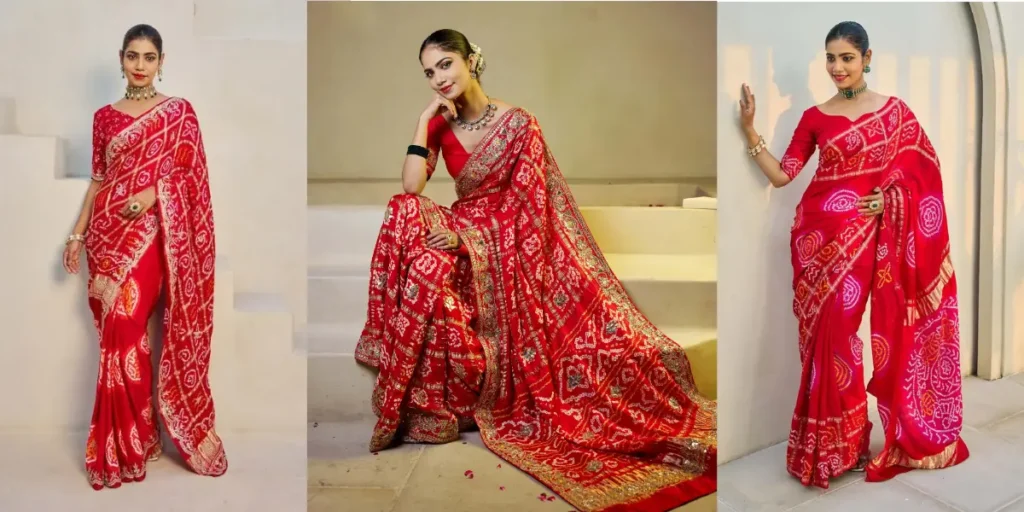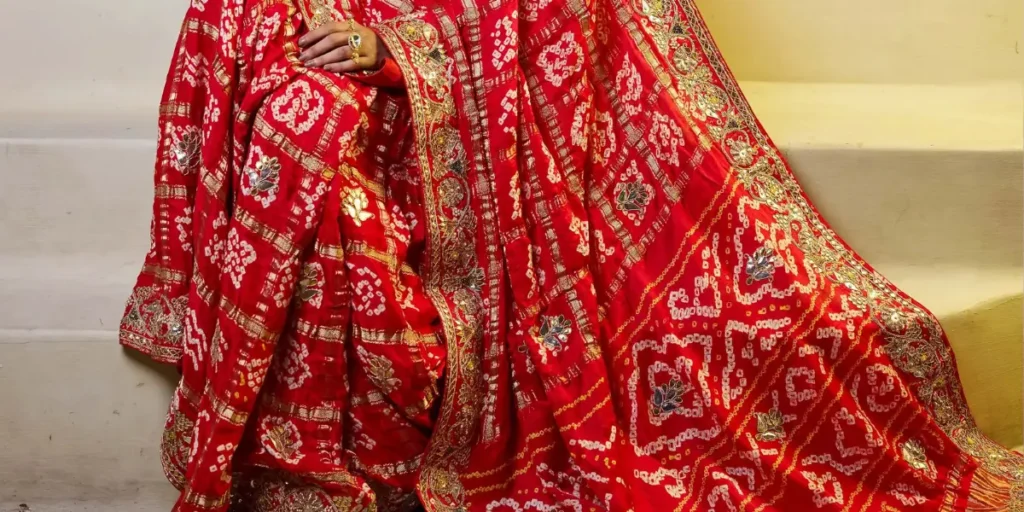Bandhani sarees are much more than just traditional Indian attire—they are works of art steeped in heritage and culture. With their vivid colors, intricate tie-dye patterns, and unparalleled craftsmanship, Bandhani sarees have remained an enduring symbol of Indian textiles. Whether it’s for a wedding, a festival, or simply a special occasion, Bandhani sarees continue to enchant women across the world with their beauty and charm.
This article delves deep into the artistry, history, and modern appeal of Bandhani sarees, showcasing why they deserve a prominent place in every saree lover’s wardrobe.

What Are Bandhani Sarees?
Bandhani sarees, also known as Bandhej sarees, are a type of tie-dye saree traditionally made in the states of Gujarat, Rajasthan, and parts of Uttar Pradesh. The word “Bandhani” is derived from the Sanskrit word “Bandha,” meaning to tie. The process involves tying small portions of fabric with threads and then dyeing them to create mesmerizing patterns.
The result? A saree adorned with vibrant dots, squares, waves, and other intricate motifs, each telling its own story of artistry and craftsmanship.
The History and Legacy of Bandhani Sarees
The art of Bandhani dates back over 5,000 years, making it one of the oldest forms of textile design in the world. Bandhani sarees have been mentioned in ancient Indian texts, and sculptures have depicted women draped in similar tie-dyed fabrics.
This craft was traditionally practiced by the Khatri community of Gujarat and Rajasthan, who passed down their skills through generations. Bandhani sarees were often worn by royalty and aristocracy, symbolizing prosperity, tradition, and auspicious beginnings.
The Craftsmanship Behind Bandhani Sarees
The beauty of Bandhani sarees lies in the painstaking craftsmanship involved in their creation. The process includes:
1. Tying the Fabric
Artisans use threads to tie small portions of the fabric into knots. The tighter the knot, the sharper the pattern will appear after dyeing.
2. Dyeing the Saree
The saree is then dyed in vibrant colors, with artisans often layering multiple dyes to create complex designs. Traditional Bandhani sarees use natural dyes, such as indigo, turmeric, and pomegranate peels.
3. Unveiling the Magic
Once the fabric is dried, the knots are untied, revealing intricate patterns. The symmetry, precision, and vividness of the designs reflect the artisan’s expertise.
Types of Bandhani Sarees
Leheriya Bandhani Sarees
Leheriya sarees feature wave-like patterns created using diagonal tie-dye techniques. These sarees are typically made in vibrant colors like yellow, orange, and pink, making them perfect for festive occasions.
Gota Patti Bandhani Sarees
A combination of Bandhani tie-dye and gota patti embroidery, these sarees are popular for weddings. The gota work adds a touch of sparkle, making them perfect for brides or festive gatherings.
Ek Dali and Tikunthi Bandhani Sarees
These sarees are known for their specific patterns. Ek Dali features single-dot designs, while Tikunthi displays clusters of three dots, showcasing the artistry of the tie-dye process.
Borjaal Bandhani Sarees
Borjaal sarees feature intricate jaali (net-like) patterns, often with floral motifs. They exude sophistication and are highly sought after for their detailed designs.
Why Bandhani Sarees Are a Must-Have
Vibrant Colors for Every Occasion
One of the defining features of Bandhani sarees is their vibrant color palette. From bold reds and yellows to serene blues and greens, there’s a shade for every mood and celebration.
Timeless Appeal
Bandhani sarees have stood the test of time, blending traditional craftsmanship with contemporary styles. Whether you pair them with classic gold jewelry or modern accessories, they remain effortlessly chic.
Comfort and Versatility
Made from lightweight fabrics like cotton and georgette, Bandhani sarees are as comfortable as they are elegant. They can be worn year-round, making them ideal for both casual and formal occasions.

Styling Tips for Bandhani Sarees
Traditional Look
Pair your Bandhani saree with oxidized silver jewelry or kundan pieces for a traditional look. Add a bindi and tie your hair into a bun adorned with fresh flowers for a classic finish.
Fusion Style
Give your Bandhani saree a modern twist by pairing it with a crop top or jacket blouse. Add chunky boho jewelry and opt for a messy bun to create a trendy fusion look.
Contemporary Minimalism
For a minimalist yet elegant style, choose a monochromatic Bandhani saree and pair it with a sleek blouse. Opt for understated jewelry like a pair of pearl studs and a bracelet.
How to Identify Authentic Bandhani Sarees
With the rise in popularity of Bandhani sarees, counterfeit versions are often sold in the market. Here’s how you can identify an authentic Bandhani saree:
- Look for Fine Patterns: Authentic Bandhani sarees have intricate and uniform patterns, while fake ones may have blurry or irregular designs.
- Feel the Fabric: Original Bandhani sarees are made from natural fabrics like silk, cotton, or georgette. Fake versions may use synthetic materials.
- Check the Dyes: Genuine Bandhani sarees use natural dyes, which have a rich, earthy finish. Artificial dyes may appear overly bright or harsh.
Caring for Your Bandhani Saree
To keep your Bandhani saree looking beautiful for years:
- Dry Clean Only: Avoid washing your Bandhani saree at home to preserve its colors and fabric quality.
- Store Properly: Fold your saree neatly and store it in a cotton or muslin cloth to protect it from dust and moisture.
- Avoid Direct Sunlight: Prolonged exposure to sunlight can cause the colors to fade.
Why Bandhani Sarees Are a Bridal Favorite
In Indian weddings, Bandhani sarees hold special significance, particularly in Gujarat and Rajasthan. Brides often choose red or maroon Bandhani sarees adorned with intricate patterns and zari work. These sarees symbolize prosperity, love, and new beginnings.
Modern brides are also experimenting with pastel Bandhani sarees and combining them with statement jewelry to create a contemporary bridal look.
FAQs
What makes Bandhani sarees unique?
Bandhani sarees are unique because of their intricate tie-dye patterns, vibrant colors, and traditional craftsmanship.
Are Bandhani sarees suitable for weddings?
Yes, Bandhani sarees are a popular choice for weddings, especially when paired with zari work or gota patti embroidery.
Can I wear a Bandhani saree for casual occasions?
Absolutely! Lightweight Bandhani sarees in cotton or georgette are perfect for casual outings or small gatherings.
How do I choose the right Bandhani saree color?
Consider your skin tone, the occasion, and personal preferences. Red, yellow, and green are traditional choices, while pastels are great for modern looks.
Can Bandhani sarees be customized?
Yes, many artisans offer customized Bandhani sarees, allowing you to choose colors, patterns, and embellishments to suit your preferences.
Conclusion
The beauty of Bandhani sarees lies in their timeless appeal and rich cultural heritage. From traditional Leheriya patterns to contemporary designs, Bandhani sarees offer something for every woman and every occasion. Whether you’re a bride, a saree enthusiast, or simply someone looking to embrace a piece of India’s artistic legacy, a Bandhani saree is a perfect choice. Celebrate the artistry and tradition of Bandhani sarees by adding one (or more!) to your collection—you won’t regret it!
